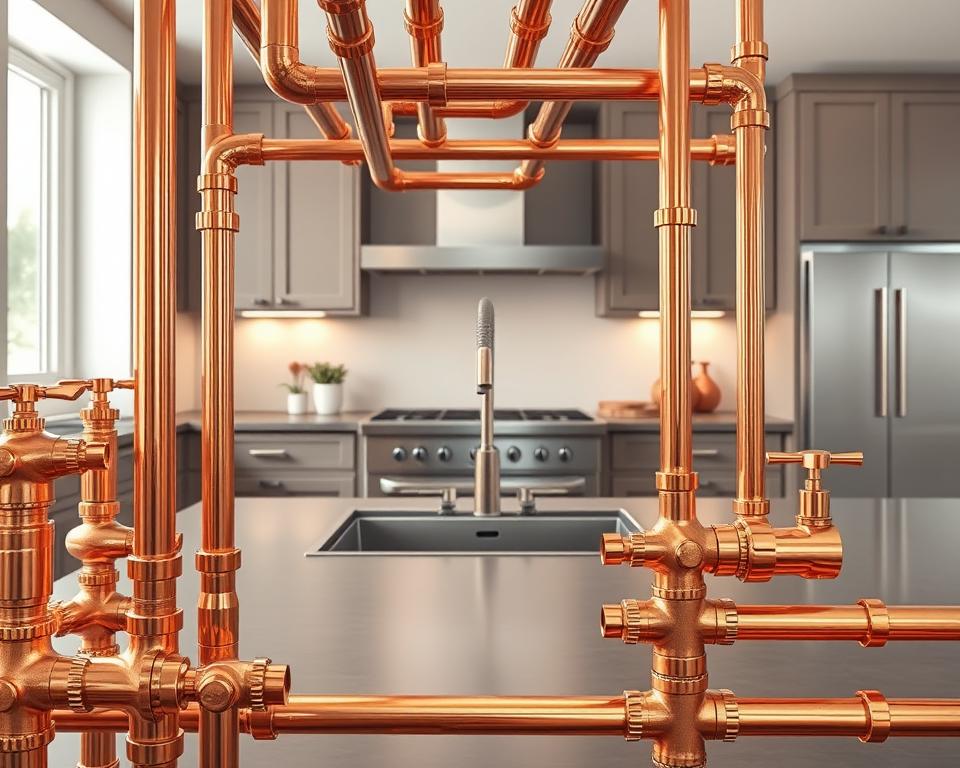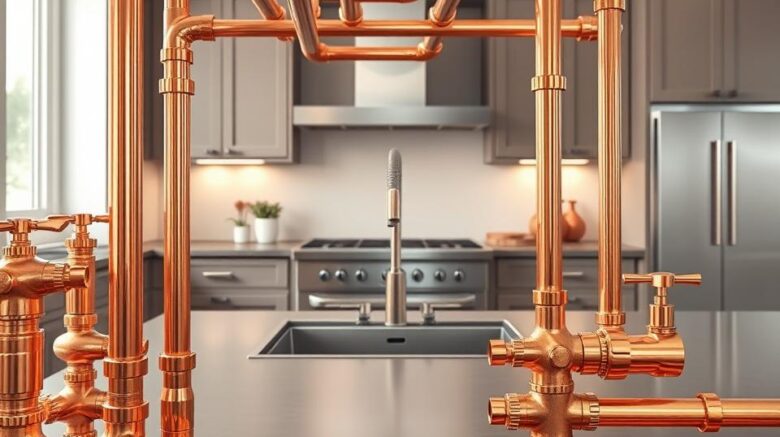Your Guide to Copper Water Line Sizing at Home
It may surprise you that approximately 30% of residential plumbing failures come from improper pipe sizing. Selecting correct sizes guarantees peak water pressure and overall system performance. Here’s a homeowner’s primer on the sizing essentials for residential water projects.
Determining the right size relies on considerations like required flow and wall measurement. Industry-standard 3/8 copper pipe spans diameters from 1/4″ up to 8″, indicated by NPS (Nominal Pipe Size) versus true OD. Installation Parts Supply offers expert guidance to match your home’s needs with compliant solutions.
Copper continues leading the pack because of its strength and ability to resist corrosion. Whether retrofitting your setup or installing from scratch, knowing these principles cuts downtime and avoids costly mishaps.
Essential Points

- Accurate sizing stops 30% of usual plumbing issues
- Standard diameters range from 1/4″ to 8″
- NPS labels don’t match real outer diameters
- Proper sizing maintains water pressure and efficiency
- Copper provides robustness and corrosion defense
- Professional guidance ensures code compliance
Why Copper Pipes Are Ideal for Your Plumbing?
Long-lasting plumbing begins by choosing the proper material—copper excels for these reasons. Its 50+ year lifespan and NSF certification for drinking water make it a top pick for homeowners. Different from other options, it marries toughness and eco-friendliness.
Toughness and Rust Protection
Resisting rust and chemicals by nature, copper outlasts PVC and PEX. A slick inner surface minimizes friction to preserve water pressure Field cases demonstrate leak-free decades-long service.
Installation Parts Supply carries certified quality products suited to your project. While initial costs are higher, the long-term savings from fewer repairs justify the investment.
Bendability and Freeze Safety
In frost-prone areas, its minor freeze expansion helps avert pipe bursts. This give lowers the likelihood of pricey cold-weather failures. Combine with adequate insulation to optimize freeze defense.
Sustainable and Germ-Fighting Properties
Fully recyclable, copper lessens ecological footprint. Its germ-killing traits help safeguard against bacterial contamination. Green-minded homeowners prefer it to plastic options.
Mastering Copper Water Line Measurements and Styles
Pipe sizing can baffle homeowners—this section clarifies it. The industry uses Nominal Pipe Size (NPS), which doesn’t match the actual outer dimensions. For example, a 1/2″ NPS has an outer diameter of 0.625″.
Labeled vs. True Pipe Sizes
NPS numbers are labels, not exact measurements. Confirm true OD prior to purchase. Refer to this chart:
- 1/4″ nominal → 0.375″ actual
- 1/2″ NPS corresponds to 0.625″ OD
- 3/4″ nominal → 0.875″ actual
L vs. M vs. K Copper Pipes
Residential plumbing relies on three major copper types. Wall gauge dictates where they’re best applied:
- Type L: Light-wall (0.040″ for 1/2″), ideal for most homes.
- Type M: Medium-wall (0.050″ for 1/2″), balances cost and durability.
- Type K: Heavy gauge (0.060″ @ 1/2″), ideal under high PSI.
Installation Parts Supply recommends Type M for general plumbing due to its versatility. Over 2″ spans usually need Type K for irrigation or business applications.
L-Type Copper Pipes: Slim and Adaptable
Home handymen find L-type superbly easy to shape. Its thin-wall construction reduces weight and cost while maintaining reliability. Available in rigid sticks or soft coils, it adapts to everything from HVAC lines to drain systems.
Common Applications and Limitations
L-type excels in low-pressure scenarios. A 0.040″ gauge suits:
- HVAC refrigerant lines
- Drain-waste-vent (DWV) systems
- Residential water supply (below 80 PSI)
Not for high PSI—opt for Type K if stress exceeds limits. Coils (max 50ft) ease around corners but must be bent cautiously to avoid kinks.
Sizing Options and Installation Tips
Available in sizes 1/4″–8″, most often:
| Form | Max Length | Best For |
|---|---|---|
| Rigid | 20ft | Straight runs |
| Coiled | 50ft | Tight spaces |
Installation Parts Supply recommends rigid forms for beginners—they’re easier to cut and solder. When tackling big installations, coils mean fewer joints, saving time and leak hazards.
Type M Copper: Balanced Performance
Balancing cost and performance, M-type emerges as the top pick for modern homes. Its medium-wall design handles everyday demands while keeping budgets in check. NSF potable-water and gas approval means trust in kitchens, baths, heating runs.
Where M-Type Shines
Perfect for mixed hot/cold service, keeping water pressure uniform. Rigid 12ft lengths suit straight runs, while 100ft coils adapt to tight spaces. Typical uses cover:
- Drinking water distribution
- Medical gas lines (oxygen, nitrous oxide)
- HVAC refrigerant lines
Wall Thickness and Pressure Tolerance
M-type strikes a balance between L and K types. With 0.050″ walls, it tolerates up to 150 PSI without failure. Compare key specs:
| Type | Wall Thickness (1/2″) | Max Pressure | Best For |
|---|---|---|---|
| L | 0.040″ | 80 PSI | Low-pressure DWV |
| M | 0.050″ | 150 PSI | Residential supply |
| K | 0.060″ | 200 PSI | Irrigation |
Installation Parts Supply stocks M-type in all standard sizes. Use flare fittings on gas runs to avoid leaks. Allow slight expansion gaps in hot water runs to accommodate thermal movement.
Type K Copper for Tough Applications
Under the toughest conditions, K-type provides exceptional endurance. Heavy walls plus high PSI capacity suit it to industrial or buried lines. Unlike thinner alternatives, it resists crushing and corrosion in harsh environments.
Heavy-Duty Use Cases
K-type thrives in extreme conditions. At 0.060″ gauge, it manages 200 PSI, ideal for:
- Underground irrigation systems
- Commercial HVAC refrigerant lines
- Fire sprinkler networks
When burying, Installation Parts Supply suggests at least 18″ cover. Combine with compression fittings torqued at 25 ft·lb to ensure leak-free performance.
How to Choose Rigid or Coiled K-Type
Pick rigid or coil depending on application. Use 12ft rigid lengths for straight lines; 50ft coils for curves. See their differences:
| Form | Best For | Limitations |
|---|---|---|
| Rigid | High-pressure mains | Requires more fittings |
| Coiled | Trenchless installations | Risk of kinks if bent sharply |
For irrigation, design loops with 10% expansion gaps. Avoid bending rigid forms without a tube bender—kinks reduce flow efficiency.
Copper Pipe Installation & Maintenance
Following best practices leads to long-lasting, leakless service. DIYers or professionals alike benefit from mastering these fundamentals. Follow these methods to achieve secure, long-lasting results.
Soldering vs. Compression vs. Push-Fit
Choose the right technique based on your project’s needs. Use solder or compression for lasting joins; temporary fittings for flexibility. Compare the pros and cons:
| Method | Pros | Cons | Best For |
|---|---|---|---|
| Soldering | Strong, permanent | Requires skill | Water supply lines |
| Compression | No heat needed | Bulky fittings | Tight spaces |
| Push-Fit | Quick installation | Higher cost | Emergency repairs |
Step-by-Step Soldering Guide
To solder properly, proceed as follows:
- Clean surfaces with emery cloth.
- Coat each piece evenly with flux.
- Apply torch heat until you hear the flux hiss.
- Feed solder to the joint; capillary action pulls it through.
Protective gloves and fresh air are a must. Lead-free solder for potable lines is available at Installation Parts Supply.
Avoiding Drips and Freeze Breaks
Wrap pipes in unheated zones with foam sleeves. Install insulating sleeves on wall-penetrating sections. Repair advice includes:
- Check joints annually for green corrosion (a sign of leaks).
- Hang horizontal pipes at 32 inches intervals to avoid sag.
- Use frost-resistant faucets where temperatures drop.
Annual inspections catch minor issues before they escalate. Stash wrenches, cutters, and Teflon tape in your kit for fast repairs.
Final Thoughts on Copper Pipe Selection
A well-planned system lasts decades—let’s wrap up with key takeaways. Pick the correct gauge and diameter to maximize durability. Keep in mind:
- M-type works for most residences; K fits heavy-duty applications
- Accurate dimensions keep pressure up and leaks down
- Frost defense matters where it gets cold
Installation Parts Supply offers expert guidance to simplify choices. Their certified products come with quality guarantees, ensuring your plumbing systems perform flawlessly.
Looking for assistance? Get free sizing charts or book a consultation now. New customers enjoy special discounts—launch your project on the right foot!
